Related Research Articles

A comic strip is a sequence of cartoons, arranged in interrelated panels to display brief humor or form a narrative, often serialized, with text in balloons and captions. Traditionally, throughout the 20th and into the 21st century, these have been published in newspapers and magazines, with daily horizontal strips printed in black-and-white in newspapers, while Sunday papers offered longer sequences in special color comics sections. With the advent of the internet, online comic strips began to appear as webcomics.

A cartoon is a type of visual art that is typically drawn, frequently animated, in an unrealistic or semi-realistic style. The specific meaning has evolved, but the modern usage usually refers to either: an image or series of images intended for satire, caricature, or humor; or a motion picture that relies on a sequence of illustrations for its animation. Someone who creates cartoons in the first sense is called a cartoonist, and in the second sense they are usually called an animator.

The National Cartoonists Society (NCS) is an organization of professional cartoonists in the United States. It presents the National Cartoonists Society Awards. The Society was born in 1946 when groups of cartoonists got together to entertain the troops. They enjoyed each other's company and decided to meet on a regular basis.
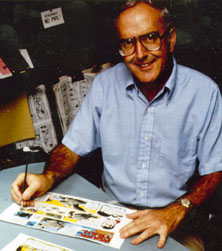
A cartoonist is a visual artist who specializes in both drawing and writing cartoons or comics. Cartoonists differ from comics writers or comic book illustrators in that they produce both the literary and graphic components of the work as part of their practice. Cartoonists may work in a variety of formats, including booklets, comic strips, comic books, editorial cartoons, graphic novels, manuals, gag cartoons, storyboards, posters, shirts, books, advertisements, greeting cards, magazines, newspapers, webcomics, and video game packaging.

John Lewis Hart was an American cartoonist noted as the creator of the comic strips B.C. and The Wizard of Id. Brant Parker co-produced and illustrated The Wizard of Id. Hart was recognized with several awards, including the Swedish Adamson Award and five from the National Cartoonists Society. In his later years, he was known for incorporating Christian themes and messages into his strips. Hart was referred to by Chuck Colson in a Breakpoint column as "the most widely read Christian of our time," over C. S. Lewis, Frank E. Peretti, and Billy Graham.
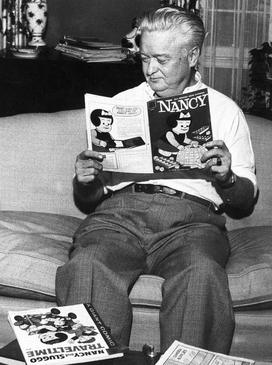
Ernest Paul Bushmiller Jr. was an American cartoonist, best known for creating the daily comic strip Nancy, which premiered in 1938 and features the title character who has remained in print for over 85 years. His work is noted for its simple graphic style. In 1976, he received the Reuben Award from the National Cartoonists Society for his work on Nancy.

William Aloysius "Bil" Keane was an American cartoonist most notable for his work on the newspaper comic The Family Circus. It began in 1960 and continues in syndication, drawn by his son Jeff Keane.
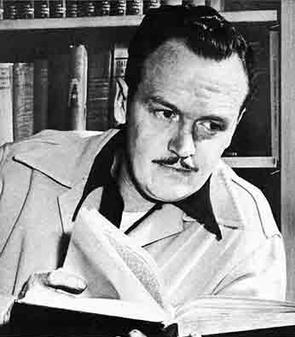
Alexander Gillespie Raymond Jr. was an American cartoonist and illustrator who was best known for creating the Flash Gordon comic strip for King Features Syndicate in 1934. The strip was subsequently adapted into many other media, from three Universal movie serials to a 1950s television series and a 1980 feature film.

Frank Oscar King was an American cartoonist best known for his comic strip Gasoline Alley. In addition to innovations with color and page design, King introduced real-time continuity in comic strips by showing his characters aging over generations.

David Wiley Miller is an American cartoonist whose work is characterized by wry wit and trenchant social satire, is best known for his comic strip Non Sequitur, which he signs Wiley. Non Sequitur is the only cartoon to win National Cartoonists Society Divisional Awards in both the comic strip and comic panel categories, and Miller is the only cartoonist to win an NCS Divisional Award in his first year of syndication.

The Born Loser is a newspaper comic strip created by Art Sansom in 1965. His son, Chip Sansom, who started assisting on the strip in 1989, is the current artist. The strip is distributed by Newspaper Enterprise Association. The Sansoms won the 1987 National Cartoonists Society Humor Comic Strip Award and the 1990 Newspaper Comic Strip Award.
A daily strip is a newspaper comic strip format, appearing on weekdays, Monday through Saturday, as contrasted with a Sunday strip, which typically only appears on Sundays. They typically are smaller, 3-4 grids compared to the full page Sunday strip and are black and white.

The Lockhorns is a United States single-panel cartoon created September 9, 1968 by Bill Hoest and distributed by King Features Syndicate to 500 newspapers in 23 countries. It is continued today by Bunny Hoest and John Reiner.

The Sunday comics or Sunday strip is the comic strip section carried in most western newspapers. Compared to weekday comics, Sunday comics tend to be full pages and are in color. Many newspaper readers called this section the Sunday funnies, the funny papers or simply the funnies.
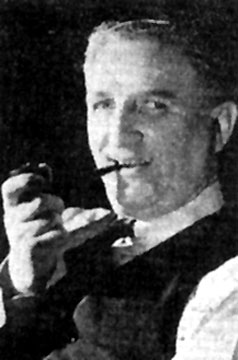
Martin Michael Branner, known to his friends as Mike Branner, was a cartoonist who created the popular comic strip Winnie Winkle.

Grin and Bear It is a former daily comic panel created by George Lichtenstein under the pen name George Lichty. Lichty created Grin and Bear it in 1932 and it ran 83 years until 2015, making it the 10th-longest-running comic strip in American history. Frequent subjects included computers, excessive capitalism and Soviet bureaucracy. Situations in his cartoons often took place in the offices of commissars, or the showrooms of "Belchfire" dealers with enormous cars in the background. His series "Is Party Line, Comrade!" skewered Soviet bureaucrats, always wearing a five-pointed star medal with the label "Hero".
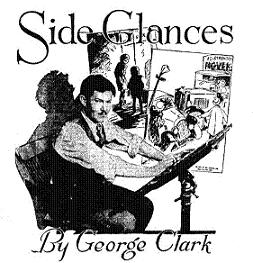
George Rife Clark was an American cartoonist best known for his syndicated cartoon panels The Neighbors and Side Glances. For both, Clark employed a loose, naturalistic drawing style to illustrate minor human foibles and familiar family situations. In the mid-1930s, George Jean Nathan's The American Spectator commented, "Clark, creator of Side Glances, deserves unqualified recognition for a penetrating picture of our middle class."

William Pierce Hoest was an American cartoonist best known as the creator of the gag panel series, The Lockhorns, distributed by King Features Syndicate to 500 newspapers in 23 countries, and Laugh Parade for Parade. He also created other syndicated strips and panels for King Features.

Henry Boltinoff was an American cartoonist who worked for both comic strips and comic books. He was a prolific cartoonist and drew many of the humor and filler strips that appeared in National Periodical comics from the 1940s through the 1960s.
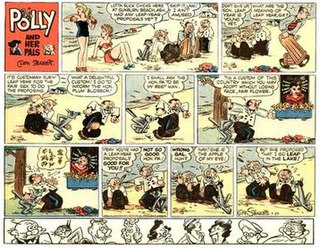
Polly and Her Pals is an American comic strip, created by cartoonist Cliff Sterrett, which ran from December 4, 1912, until December 7, 1958. It is regarded as one of the most graphically innovative strips of the 20th century. It debuted as Positive Polly on December 4, 1912, in William Randolph Hearst's newspapers, initially the New York Journal, and was later distributed by King Features Syndicate. The title changed to Polly and Her Pals on January 17, 1913.
References
- 1 2 Holtz, Allan (2012). American Newspaper Comics: An Encyclopedic Reference Guide. Ann Arbor: The University of Michigan Press. p. 285. ISBN 9780472117567.
- ↑ Becker, Stephen. Comic Art in America, Simon & Schuster, 1959.
- ↑ Lambiek: "George Clark"